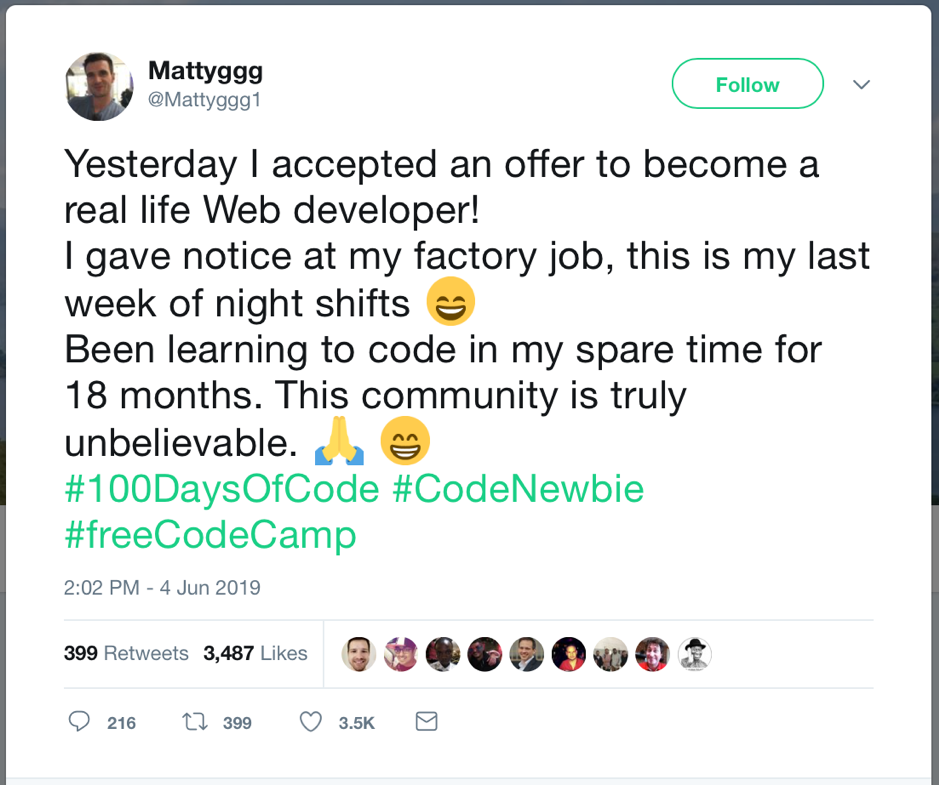Perspectives
The Future of Work is (More) Fun – Part 2
20 June, 2019 | Written by: Holly Cummins
Categorized: Artificial Intelligence | Perspectives
Share this post:
Automation eliminates toil
When the printing press was invented, it almost immediately eliminated the arduous practice of copying books by hand. (Before the printing press, writing out the pages for a single bible would take around three months.) This life-changing mechanization accelerated with the industrial revolution, and many labour-intensive tasks were automated. This included factory activities, such as spinning and weaving, but also domestic activities such as laundry. (Washing a household’s clothes by hand is hard, heavy, soggy, work, and not fun.) As we progressed from the industrial revolution to the computer one, some mental tasks were also automated; I learned when I watched Hidden Figures that in 1950 ‘a computer’ was a person who did sums (!), but by 1970 ‘a computer’ was a machine. In the near horizon, it seems clear that many food preparation, retail, agriculture, manufacturing, and transport activities will be automated. According to an OECD report, “the tasks that AI and robots cannot do are shrinking rapidly.”
Many of these technological advancements created social disruption as labour demand changed. “Luddite” now means someone who prefers not to use new technology, but it originally referred to a protest movement of skilled textile workers who attacked the early automated looms, knitting machines, and lacemaking machines which had replaced them. Although they displaced jobs, sometimes painfully, new technologies also opened up new skills and roles. As technology developed, people discovered they could become typists, engineers, machinists, mechanics, vehicle drivers, computer programmers, and (in the last ten or twenty years) data scientists.
In general (at least in recent times), these new jobs have been more pleasant, safer, and more creative than the ones which were eliminated. The World Economic Forum predicts that by 2020, one of the most in-demand skills will be creativity. Other areas where demand is growing rapidly are complex problem solving skills and social skills. Being creative, solving problems, and being social feels good, so employment based on those skills is a promising foundation for work being fun – or at the very least, rewarding.
In Singapore, Bremen, Germany, and in France, the postal service is responding to declining postal revenues by partnering with local government, healthcare, and welfare agencies to pilot schemes known as Herbsthelfer (in Bremen) and ‘Veiller sur mes parents’ (in France). As well as delivering mail, postal workers will check in on elderly citizens, have a chat, withdraw and deliver cash, deliver prescriptions and even send a reassuring “your loved one is still fine” text message to relatives afterwards. The postal workers involved reported that these social interactions ended up being the most enjoyable part of their jobs.
Artificial Intelligence
As computers become smarter, whole new categories of tasks are being automated. In the IBM Garage, we created an app for a pet retailer who worked out they were spending a lot of money a year counting fish. Like all inventory, the fish needed stock-checking, but fish are a particularly wriggly and tricky form of stock to check. Counting the fish by hand was expensive, and it was also tedious for the staff, who would rather be helping customers. Counting fish is not fun – could IBM Watson count the fish instead? It turns out that Watson can count fish, and as a double benefit, teaching a computer to count fish was fun for us. (That’s not always the case; training AI usually requires huge quantities of labelled data, and labelling that data can be pretty repetitive.)
Inclusion and New Collar
Intelligent automation is disrupting economies around the world. It’s a complex issue, but most analyses predict that technology-related job losses in some sectors will more or less be balanced out by technology-related job gains in other sectors, so that the impact of technology on overall employment is broadly neutral. However, job losses will disproportionately affect the young and those with fewer skills, since low-skill low-income jobs are most vulnerable to automation. This creates an inclusion problem and an equality problem; parts of society fear that technology is not going to be good for their future and feel disenfranchised by the changes.
IBM CEO Ginni Rometty has been doing a lot of thinking about the future of work. She spoke on the subject at the World Economic Summit in Davos, and she co-led an education working group at France’s Tech for Good Summit. Ginni argues that just as like electricity was introduced at the same time as high school education become standard across North America and Europe, the new technologies need to be accompanied by a similar social shift in education. However, this time the change may be to reduce requirements for formal education, rather than increasing them. Highly structured degrees are less appropriate in an environment which is changing rapidly. Instead, business and government need to collaborate to on apprenticeships, vocational training, and on-the-job training to create new collar jobs. As Ginni says, “those of us who benefit from the technologies, we have a really serious duty about this because these technologies are moving faster in time than their skills are going to change.”
For example, in France, IBM created the P-TECH programme in 2011 to open new employment pathways, by creating a direct connection between secondary school or lycée, college and career. The objective is to help students graduate with a secondary school diploma and then an associate degree aligned to industry needs, through workplace experiences, including mentorship and internships. I loved doing my degree so much that I did several, but I know not everyone finds the education experience fun. It’s a positive change that people who don’t derive satisfaction from university aren’t forced down that path to get a decent job.
Bootcamps, community initiatives, and charities are also working to help people develop skills in in-demand areas. One of my favourites is freecodecamp (totally free, as the name suggests, and cleverly designed so that it’s fun to do. I’m also inspired by the #100daysofcode twitter community. It’s hard not to share in the joy of some of the participants:

Although it can feel unsettling, I think the rapid pace of change and continuous demand for new skills has some really positive aspects. Many of us will need to be doing more learning in the future. What’s one of the most effective ways to learn? Play. What’s another great way of learning? Exploration. Those are both fun, and so learning new things (if it’s done right) can be totally fun.
The challenge of bias
Even if it doesn’t take our jobs, increasing automation raises some profound questions. What if we automate tasks, but the automation gets it wrong? In particular, AI systems only know what they’re trained on, so they’re vulnerable to ‘bias in, bias out’ problems that reinforce existing inequalities. Machine learning, by its very nature, is always a form of statistical discrimination, but the discrimination becomes objectionable when it places certain privileged groups at systematic advantage and certain unprivileged groups at systematic disadvantage. It’s also objectionable when it’s just plain wrong. Consider the famous example of black faces in photos being tagged as gorillas, which managed to be objectionable on both counts. Image search results for professions like CEO or author also disproportionately show white men (relative to actual labour statistics for those roles).
What’s going on? Bias in training data, due to either prejudice in labels or under and over-sampling, yields models with unwanted bias. The good news is that AI may also be part of the solution, both by exposing hidden biases, and also by giving us the tools to be more objective than we can be on our own.
For example, AI can also help boost diversity in hiring by encouraging clear hiring criteria, catching unconscious bias, and searching for candidates in broader pools than human recruiters can manage without help. IBM is open-sourcing toolkits aimed at detecting and mitigating bias in AI algorithms, such as Fairness 360. IBM has also created a free data set of a million faces, designed with diversity and representation in mind.
Remember Grady Booch, happily working in Hawaii? He’s given a lovely TED talk arguing that we shouldn’t fear AI, because (by definition, because of how it’s trained) it embodies the values of those who trained it – us. We don’t all have the same values, and some of what we see reflected in the mirror of AI is upsetting (Tay the racist chatbot springs to mind). But ultimately, our goal of using AI is to be happier, fairer, and touch the stars. I look forward to working in deeper partnership with computerised assistants so that I can do more and focus on the things that I do best.

WW Development Discipline Leader - Cloud Garage IBM Cloud and Cognitive Software
Frontier Fusion: Accelerating the Path to Net Zero with Next Generation Innovation
Delivering the world’s first fusion powerplants has long been referred to as a grand challenge – requiring international collaboration across a broad range of technical disciplines at the forefront of science and engineering. To recreate a star here on Earth requires a complex piece of engineering called a “tokamak” essentially, a “magnetic bottle”. Our […]
Unlocking the Future of Financial Services with IBM Consulting at Think London 2024
In a world where financial services are evolving at an unprecedented pace, staying ahead of the curve is crucial. The recent IBM Think London event, IBM’s flagship UK event, brought together industry leaders, partners, and clients to explore how cutting-edge technologies like generative AI and hybrid cloud infrastructure are transforming the sector. For IBM […]
Converting website traffic into happy customers with a smart virtual assistant
With a long track record of guiding companies across various sectors through digital transformation, IBM Business Partner WM Promus is now focusing AI innovation. Eileen O’Mahony, General Manager at WM Promus, explains how her company helped a UK-based commercial finance brokerage enhance customer experience, and develop new sales leads using IBM watsonx and IBM […]





























